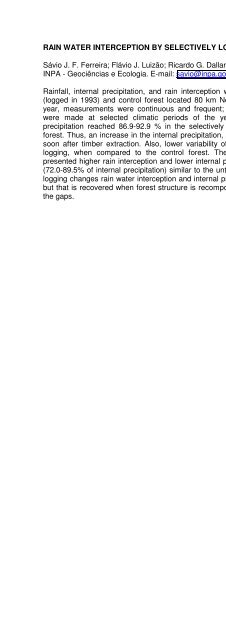A Look at Amazon Basin Seasonal Dynamics with the Biophysical ...
A Look at Amazon Basin Seasonal Dynamics with the Biophysical ... A Look at Amazon Basin Seasonal Dynamics with the Biophysical ...
RAIN WATER INTERCEPTION BY SELECTIVELY LOGGED RAIN FOREST IN CENTRAL AMAZONIASávio J. F. Ferreira; Flávio J. Luizão; Ricardo G. Dallarosa.INPA - Geociências e Ecologia. E-mail: savio@inpa.gov.brRainfall, internal precipitation, and rain interception were studied over 2 years in selectively logged plots(logged in 1993) and control forest located 80 km North of Manaus, in Central Amazonia. During the firstyear, measurements were continuous and frequent; in the following period, several intensive campaignswere made at selected climatic periods of the year: dry, wet and transitional periods. The internalprecipitation reached 86.9-92.9 % in the selectively logged plots, against 74.2-87.1 % in the untouchedforest. Thus, an increase in the internal precipitation, together with a lower rain water interception, occurredsoon after timber extraction. Also, lower variability of data was observed in the plots subject to selectivelogging, when compared to the control forest. The older managed plots (selectively logged in 1987)presented higher rain interception and lower internal precipitation than plots logged in 1993, showing values(72.0-89.5% of internal precipitation) similar to the untouched forest. It is concluded that moderate selectivelogging changes rain water interception and internal precipitation during the first years after timber extration,but that is recovered when forest structure is recomposed, within a few years, by the secondary regrowth inthe gaps.
- Page 320: Where are the oldest of the forest?
- Page 324: Tree Growth History, Stand Structur
- Page 328: Marco Rondon CGIAR Poster Carbon St
- Page 332: Selective Logging, Forest Fragmenta
- Page 336: Impacts of logging and fire on the
- Page 340: Forest Disturbance by Logging and F
- Page 344: Effect of selective logging on biom
- Page 348: Multitemporal Assessment of Selecti
- Page 352: A forest clearing experiment conduc
- Page 356: Manoel Cardoso, George Hurtt, Berri
- Page 360: Coarse Woody Debris in Logged and U
- Page 364: SOIL THERMAL PROPERTIES UNDER FORES
- Page 368: Spatial Pattern of Selective Loggin
- Page 374: PREDICTING EDGE-DRIVEN CARBON EMISS
- Page 378: Rafael FERREIRA daCOSTAMPEG Poster
- Page 382: An experiment with the Eta/SSiB mod
- Page 386: Amazonian forest die-back in the Ha
- Page 390: Simulations of South American hydro
- Page 394: Poster title: Global teleconnection
- Page 398: Contrasting conditions of atmospher
- Page 402: 1) Drought in an E. Amazonian rain
- Page 406: 3) Drought in an E. Amazonian rain
- Page 410: The influence of land surface winds
- Page 416: Water use efficiency increases in r
RAIN WATER INTERCEPTION BY SELECTIVELY LOGGED RAIN FOREST IN CENTRAL AMAZONIASávio J. F. Ferreira; Flávio J. Luizão; Ricardo G. Dallarosa.INPA - Geociências e Ecologia. E-mail: savio@inpa.gov.brRainfall, internal precipit<strong>at</strong>ion, and rain interception were studied over 2 years in selectively logged plots(logged in 1993) and control forest loc<strong>at</strong>ed 80 km North of Manaus, in Central <strong>Amazon</strong>ia. During <strong>the</strong> firstyear, measurements were continuous and frequent; in <strong>the</strong> following period, several intensive campaignswere made <strong>at</strong> selected clim<strong>at</strong>ic periods of <strong>the</strong> year: dry, wet and transitional periods. The internalprecipit<strong>at</strong>ion reached 86.9-92.9 % in <strong>the</strong> selectively logged plots, against 74.2-87.1 % in <strong>the</strong> untouchedforest. Thus, an increase in <strong>the</strong> internal precipit<strong>at</strong>ion, toge<strong>the</strong>r <strong>with</strong> a lower rain w<strong>at</strong>er interception, occurredsoon after timber extraction. Also, lower variability of d<strong>at</strong>a was observed in <strong>the</strong> plots subject to selectivelogging, when compared to <strong>the</strong> control forest. The older managed plots (selectively logged in 1987)presented higher rain interception and lower internal precipit<strong>at</strong>ion than plots logged in 1993, showing values(72.0-89.5% of internal precipit<strong>at</strong>ion) similar to <strong>the</strong> untouched forest. It is concluded th<strong>at</strong> moder<strong>at</strong>e selectivelogging changes rain w<strong>at</strong>er interception and internal precipit<strong>at</strong>ion during <strong>the</strong> first years after timber extr<strong>at</strong>ion,but th<strong>at</strong> is recovered when forest structure is recomposed, <strong>with</strong>in a few years, by <strong>the</strong> secondary regrowth in<strong>the</strong> gaps.



